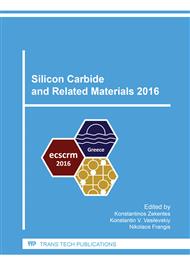p.7
p.11
p.15
p.19
p.24
p.28
p.32
p.39
p.43
SiC Solution Growth on Si Face with Extremely Low Density of Threading Screw Dislocations for Suppression of Polytype Transformation
Abstract:
In order to achieve a high-quality SiC crystal in solution growth, one of the most difficult issues is to grow a thick layer on Si face avoiding polytype transformation. In this case, two-dimensional nucleation, which leads to the polytype transformation, is frequently induced because a density of threading screw dislocations acting as a source of spiral step decreases and wide terraces form by step bunching as growth proceeds. Therefore, it is very difficult to stabilize the polytype of crystals grown with extremely low density of threading screw dislocations. In this study, we tried to overcome these problems by using specially designed seed crystal and optimizing growth temperature and temperature distribution. We successfully grew thick low-threading-dislocation density SiC crystal without polytype transformation under the condition of high growth temperature and homogeneous temperature distribution.
Info:
Periodical:
Pages:
24-27
Citation:
Online since:
May 2017
Authors:
Price:
Сopyright:
© 2017 Trans Tech Publications Ltd. All Rights Reserved
Share:
Citation:


